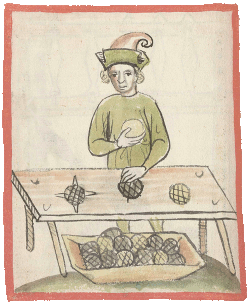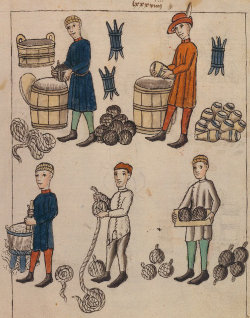 According to information in Johannes Bengedans' war book of 1440-1451, the invention of fireballs is said to have taken place only a few years earlier.1) Its functional principle is already found in the so-called fireworks book of 1420, which can presumably be related to Bengedans' statement.2)
According to information in Johannes Bengedans' war book of 1440-1451, the invention of fireballs is said to have taken place only a few years earlier.1) Its functional principle is already found in the so-called fireworks book of 1420, which can presumably be related to Bengedans' statement.2)
Fire or light bales consisted of a pouch made of linen, which was sewn together from individual fabric segments and filled with combustible mass in various compositions. This pouch was then tightly knitted with ropes and fitted with a fuse. Finally, many fireballs were given a coating of pitch or tar, which was sprinkled with sawdust or black powder to prevent the pitch from sticking. The fireballs prepared in this way could be stored in the arsenals and armouries for a long time in case of emergency.
Numerous authors recommended storing fireballs only with a temporary filling of sand and replacing this sand filling with the explosive charge only shortly before use, since powder charges absorb humidity with increasing storage time, which reduces their explosiveness. The most commonly used ingredients of the incendiary compounds were: sulphur, saltpetre, black powder, camphor, black iron oxide (iron(II,III) oxide), rosin, resin, tar, pitch, sawdust, tallow, wax, softwood shavings and others. Many of the preserved fire masses were bound with linseed oil or pitch. The simple structure of the fire bales and the cheaply procurable raw materials also made it easy to reproduce them in times of crisis. In an emergency, fireballs were lit at the fuses and thrown at the enemy. At the target, the fireballs ignited and burned down aggressively, or they exploded and spread the sticky, burning mass further.3)4) In addition to knitted variants, there were obviously incendiary balls that consisted solely of the incendiary mass bound with resin. The author of the fireworks book of University Library Freiburg Ms. 362 noted that these balls burned for a long time and very brightly. He recommended, for example, throwing a burning bullet at the enemy after a rifle shot, so that the rifle could be reloaded in peace in its protection.5) From the 16th century onwards, fireballs were often peppered with "Mordschlägen" crackers, smal metall tubes fitted with black powder charges and projectiles that fired their projectiles uncontrollably when the incendiary mass was ignited. These crackers increased the danger for opponents to approach the burning fireballs in order to extinguish or defuse them.3)4) The few surviving originals are kept in the collections of the Veste Coburg, the Bavarian Army Museum in Ingolstadt, the Dresden Armoury (Germany), the Historical Museums of Bern and Basel (Switzerland), the Museum of Military History in Vienna (Austria), as well as the Swedish Naval Museum in Karlskrona and the Army Museum in Stockholm, among others.3)
In addition to knitted variants, there were obviously incendiary balls that consisted solely of the incendiary mass bound with resin. The author of the fireworks book of University Library Freiburg Ms. 362 noted that these balls burned for a long time and very brightly. He recommended, for example, throwing a burning bullet at the enemy after a rifle shot, so that the rifle could be reloaded in peace in its protection.5) From the 16th century onwards, fireballs were often peppered with "Mordschlägen" crackers, smal metall tubes fitted with black powder charges and projectiles that fired their projectiles uncontrollably when the incendiary mass was ignited. These crackers increased the danger for opponents to approach the burning fireballs in order to extinguish or defuse them.3)4) The few surviving originals are kept in the collections of the Veste Coburg, the Bavarian Army Museum in Ingolstadt, the Dresden Armoury (Germany), the Historical Museums of Bern and Basel (Switzerland), the Museum of Military History in Vienna (Austria), as well as the Swedish Naval Museum in Karlskrona and the Army Museum in Stockholm, among others.3)
 From the year 1467, the Hamburg treasury recorded expenditures for the supply of fire balls for the bombards: "3 ℔ 18 ß dato cuidam, qui fecit probam de vurballe deserviente ad bombardas."6) Another reference from Hamburg comes from an inventory of the city armouries and fortress towers from the year 1642, which together lists about 35 fireballs as "getaufte" (literally: babtisted) probably for brisant, or "ungetaufte Feuerkugeln" (literally unabtisted fire balls) for empty ones, in the various bulwarks.7)
From the year 1467, the Hamburg treasury recorded expenditures for the supply of fire balls for the bombards: "3 ℔ 18 ß dato cuidam, qui fecit probam de vurballe deserviente ad bombardas."6) Another reference from Hamburg comes from an inventory of the city armouries and fortress towers from the year 1642, which together lists about 35 fireballs as "getaufte" (literally: babtisted) probably for brisant, or "ungetaufte Feuerkugeln" (literally unabtisted fire balls) for empty ones, in the various bulwarks.7)
Light Balls
Light bals were used for battlefield illumination. They were constructed similarly to fireballs and filled with various mixtures of saltpetre and sulphur and, in smaller proportions, coal, pitch, tar and spit shine (antimony), black powder, resin, crushed glass and other substances known as "Geschmolzen Zeug" (literally: melted stuff).3)
Reconstructions
 The reproductions of our fire balls, are based on the historical originals and on the results of Alfred Geibig, who carried out and published numerous experiments.4) A sturdy linen cloth, twine, two forged iron rings, about 20 m of hemp rope and a wooden stake are needed to make a fireball. For impregnating the ball, linseed oil, beeswax, turpentine oil, tar or pitch are also necessary. In our models, we used a filling of ash and sawdust with a similar volume weight instead of the explosive incendiary mixture. First, the segments of the incendiary bag are cut out of the linen fabric and sewn together. Afterwards, the fire bag can be coated (impregnated) with a mixture of linseed oil or beeswax and turpentine. Then the bag is turned over and the prepared incendiary or disintegrant mixture is filled in and compacted. In some of our models, as suggested in the historical recipes, we have bound the incendiary agent by adding linseed oil to form a dry paste. Then the opening of the incendiary bag is sewn up. The iron rings are placed on the poles of the sack and connected vertically with the hemp rope by half strokes. In the process, the knots on the rings are pushed close together until the starting point is reached again. Then the vertically running strands are knitted horizontally around the bale and a carrying loop is formed. Finally, the fuse is inserted. To do this, a hollowed-out piece of wood, in which the fuse is inserted, is driven through the top of the ring into the fire bag.
The reproductions of our fire balls, are based on the historical originals and on the results of Alfred Geibig, who carried out and published numerous experiments.4) A sturdy linen cloth, twine, two forged iron rings, about 20 m of hemp rope and a wooden stake are needed to make a fireball. For impregnating the ball, linseed oil, beeswax, turpentine oil, tar or pitch are also necessary. In our models, we used a filling of ash and sawdust with a similar volume weight instead of the explosive incendiary mixture. First, the segments of the incendiary bag are cut out of the linen fabric and sewn together. Afterwards, the fire bag can be coated (impregnated) with a mixture of linseed oil or beeswax and turpentine. Then the bag is turned over and the prepared incendiary or disintegrant mixture is filled in and compacted. In some of our models, as suggested in the historical recipes, we have bound the incendiary agent by adding linseed oil to form a dry paste. Then the opening of the incendiary bag is sewn up. The iron rings are placed on the poles of the sack and connected vertically with the hemp rope by half strokes. In the process, the knots on the rings are pushed close together until the starting point is reached again. Then the vertically running strands are knitted horizontally around the bale and a carrying loop is formed. Finally, the fuse is inserted. To do this, a hollowed-out piece of wood, in which the fuse is inserted, is driven through the top of the ring into the fire bag.
References
- Bengedans (1450): Chapter 17
- Unter anderem im Feuerwerkbuch der Universitätsbibliothek Freiburg i. Br., Ms. 362, fol. 85v-86r
- Geibig (2012): pp. 73-120
- Geibig (2007)
- Nibler (2005)
- Kämmereirechnungen der Stadt Hamburg: 1401-1470, p. 33434
- Neddermeyer (1832): pp. 60-62
Currency symbols: ℔ talentum (Pfund / Pound) / ß solidus (Schilling / Shilling)
Text and photos: Andreas Franzkowiak







